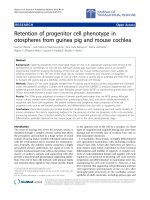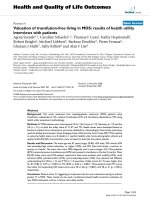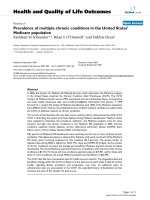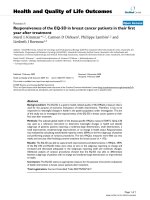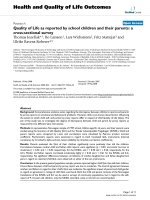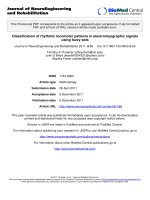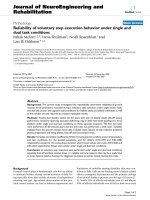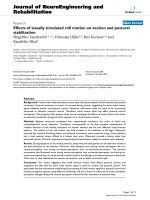báo cáo hóa học: "Estimation of minimally important differences in EQ-5D utility and VAS scores in cancer" pot
Bạn đang xem bản rút gọn của tài liệu. Xem và tải ngay bản đầy đủ của tài liệu tại đây (241.25 KB, 8 trang )
BioMed Central
Page 1 of 8
(page number not for citation purposes)
Health and Quality of Life Outcomes
Open Access
Research
Estimation of minimally important differences in EQ-5D utility and
VAS scores in cancer
A Simon Pickard*
1
, Maureen P Neary
2
and David Cella
3
Address:
1
Center for Pharmacoeconomic Research, Department of Pharmacy Practice, College of Pharmacy, University of Illinois at Chicago,
Chicago, USA,
2
Global Health Outcomes, GlaxoSmithKline, Collegeville, Pennsylvania, USA and
3
Center for Outcomes Research and Education,
Evanston Healthcare and Feinberg School of Medicine, Northwestern University, Chicago, USA
Email: A Simon Pickard* - ; Maureen P Neary - ; David Cella -
* Corresponding author
Abstract
Background: Understanding what constitutes an important difference on a HRQL measure is
critical to its interpretation. The aim of this study was to provide a range of estimates of minimally
important differences (MIDs) in EQ-5D scores in cancer and to determine if estimates are
comparable in lung cancer.
Methods: A retrospective analysis was conducted on cross-sectional data collected from 534
cancer patients, 50 of whom were lung cancer patients. A range of minimally important differences
(MIDs) in EQ-5D index-based utility (UK and US) scores and VAS scores were estimated using
both anchor-based and distribution-based (1/2 standard deviation and standard error of the
measure) approaches. Groups were anchored using Eastern Cooperative Oncology Group
performance status (PS) ratings and FACT-G total score-based quintiles.
Results: For UK-utility scores, MID estimates based on PS ranged from 0.10 to 0.12 both for all
cancers and for lung cancer subgroup. Using FACT-G quintiles, MIDs were 0.09 to 0.10 for all
cancers, and 0.07 to 0.08 for lung cancer. For US-utility scores, MIDs ranged from 0.07 to 0.09
grouped by PS for all cancers and for lung cancer; when based on FACT-G quintiles, MIDs were
0.06 to 0.07 in all cancers and 0.05 to 0.06 in lung cancer. MIDs for VAS scores were similar for
lung and all cancers, ranging from 8 to 12 (PS) and 7 to 10 (FACT-G quintiles).
Discussion: Important differences in EQ-5D utility and VAS scores were similar for all cancers and
lung cancer, with the lower end of the range of estimates closer to the MID, i.e. 0.08 for UK-index
scores, 0.06 for US-index scores, and 0.07 for VAS scores.
Background
It is common, if not usual practice, to include health-
related quality of life (HRQL) measures in clinical trials in
oncology. To justify the cost of new cancer drugs, deci-
sion-makers need to determine not only whether a drug
has a statistically significant impact on survival and/or
HRQL, but they also need to evaluate whether the
improvement is meaningful. This is particularly impor-
tant in lung cancer, where aggressive new therapies are
being brought to market. In addition to the use of cancer-
specific measures such as European Organization for
Research and Treatment of Cancer-QLQ-C30 (EORTC
QLQ-C30) [1,2]and the Functional Assessment of
Chronic Illness Therapy (FACIT) measurement system [3],
Published: 21 December 2007
Health and Quality of Life Outcomes 2007, 5:70 doi:10.1186/1477-7525-5-70
Received: 27 August 2007
Accepted: 21 December 2007
This article is available from: />© 2007 Pickard et al; licensee BioMed Central Ltd.
This is an Open Access article distributed under the terms of the Creative Commons Attribution License ( />),
which permits unrestricted use, distribution, and reproduction in any medium, provided the original work is properly cited.
Health and Quality of Life Outcomes 2007, 5:70 />Page 2 of 8
(page number not for citation purposes)
clinical trials in oncology are increasingly incorporating
generic preference-based measures such as EQ-5D. EQ-5D
is an indirect measure of utility for health that generates
an index-based summary score based upon societal pref-
erence weights [4]. Utility scores enable comparisons of
burden of disease across conditions and the calculation of
quality-adjusted life-years (QALYs), an outcome used to
compare the cost effectiveness of health care technologies.
A major challenge in HRQL measurement is the interpre-
tation of scores, particularly with respect to defining what
constitutes a minimally important difference (MID). The
MID has been defined as the smallest change in a PRO
measure that is perceived by patients as beneficial or that
would result in a change in treatment [5]. Approaches to
estimation of MIDs have been classified as either distribu-
tion-based or anchor-based [6]. Anchor-based approaches
compare changes seen in an individual's HRQL to an
external criterion, such as a clinical measure or using a
patient rated global change question. Problematically, no
single anchor represents a gold standard and no approach
is ideal. Norman et al (1997) found that retrospective glo-
bal ratings of change have questionable ability to yield
information of treatment effects [7]. Alternatively, distri-
bution-based approaches rely on the distribution of scores
and are computed using variations on effect size [8]. The
main disadvantage to distribution-based techniques is
that they do not provide insight into the importance of
the difference [9]. Often both approaches are combined,
with anchored-based HRQL changes initially framed in
terms of the individual are then further analyzed as a
group using distribution-based methods [10-15].
While MIDs have been estimated for EQ-5D index-based
scores for some conditions [16], empiric work has not
been performed in cancer. Additionally, it is not clear if
lung cancer has a different range of MID estimates. Thus,
the aim of this study was to provide a range of estimates
for meaningful difference in EQ-5D scores in cancer and
to determine if MIDs for lung cancer are different from all
cancers.
Methods
Study design
A retrospective analysis was conducted on cross-sectional
data collected from 534 cancer patients with eleven types
of cancer who participated in a validation study of cancer
symptoms scales [17]. Participants had advanced (stage 3
or 4) cancer of the bladder, brain, breast (females patients
only), colon/rectum, head/neck, liver/pancreas, kidney,
lung, lymphoma, ovary (females patients only), and pros-
tate (males patients only). All patients had received at
least 2 cycles of chemotherapy, or if chemotherapy was
non-cyclical, had been receiving it for at least 1 month.
Efforts were made to recruit 50 patients for each type of
cancer, with approximately equal proportions of male
and female patients for the non-gender specific types of
neoplasm. This dataset included 50 patients lung cancer
patients, and between 50 and 52 patients with all other
types of cancer except bladder cancer (n = 31).
The patients were recruited from six sites within the
National Cancer Coalition Network (NCCN) and the
Cancer Health Alliance of Metropolitan Chicago
(CHAMC). The NCCN is a not for profit, tax-exempt cor-
poration that is an alliance of National Cancer Institute
(NCI) approved comprehensive cancer centers. The
CHAMC organizations provide social, emotional and
informational support services to cancer patients free of
charge. These organizations are not affiliated with a med-
ical center or university, and each CHAMC agency serves
different geographical and socio-demographic cancer
patient populations. All patients who completed the ques-
tionnaires consented to participate in the study. Institu-
tional review board approval was obtained for secondary
data analysis (University of Illinois at Chicago research
protocol #2006-0891).
Measures
Patients completed several questionnaires, including the
EQ-5D and the Functional Assessment of Cancer Therapy
(FACT). The EQ-5D descriptive system consists of 5
dimensions: Mobility, Self-Care, Usual Activities, Pain/
Discomfort, and Anxiety/Depression, each with 3 levels
(e.g. no problems, moderate problems, extreme prob-
lems) [18]. Index-based summary scores were calculated
based on 2 different algorithms using societal preference
developed from general population-based valuation stud-
ies in the United Kingdom [19] and the USA [20]. The
index-based score is typically interpreted along a contin-
uum where 1 represents best possible health and 0 repre-
sents dead, with some health states being worse than dead
(<0). In addition to the self-classifier, respondents rate
their health today using a 20 centimeter visual analogue
scale (VAS) that ranges from 0 (worst imaginable health
state) to 100 (best imaginable health state).
Participants also completed the Functional Assessment of
Cancer Therapy (FACT) quality of life questionnaire using
a version specific to their tumor type. The general sub-
scales common to all versions (FACT-G) include physical
well-being (PWB), social/family well-being (SFWB), emo-
tional well-being (EWB), and functional well-being
(FWB). The FACT-G total score (FACT-G Total) is based
on 26 summed items (responses 0 to 4) from the PWB (7
items), FWB (7 items), SFWB (6 items), and EWB (6
items). Higher scores represent better quality of life.
Performance status was evaluated using the Eastern Can-
cer Oncology Group (ECOG) classification system [21].
Health and Quality of Life Outcomes 2007, 5:70 />Page 3 of 8
(page number not for citation purposes)
ECOG grades range from 0, which is fully active, to 4,
completely disabled, and 5 is dead. ECOG grades are used
by physicians and researchers to assess progression of dis-
ease, impact of the disease on daily activities, and to guide
appropriate treatment and prognosis.
Analysis
Both anchor-based and distribution-based approaches
were used to estimate MIDs for the EQ-5D in the overall
cancer cohort, and in the subgroup of lung cancer
patients, when possible. Distribution-based criteria
included: 1/2 standard deviation (SD) and the standard
error of the measure (SEM) [22]. For consistency with past
studies exploring MIDs, 1/3 SD was also reported, but it
was not included in the summarized range of MIDs as
there is less evidence to support that 1/3 SD represents an
important difference. The SEM is calculated as
where r is reliability of the measure. It is
debatable which type of reliability, internal consistency or
test-retest (TRT) reliability, is most appropriate. Very lim-
ited evidence of TRT reliability is available on the EQ-5D
in cancer [4]. Because the EQ-5D has single item dimen-
sions, internal consistency reliability does not apply to
each dimension. Although HRQL is considered a multi-
dimensional construct, the aggregation of dimensional
responses to create a single summary score is an implicit
endorsement of HRQL as an overarching construct. How-
ever, item response theory-based analysis of the dimen-
sional structure of the EQ-5D has indicated that the
anxiety/depression dimension taps into a construct dis-
tinct from the other 4 items [23]. Calculation of internal
consistency reliability using Cronbach's alpha was 0.68,
regardless of whether or not anxiety/depression was
included. Thus, for the purposes of our analysis, a reliabil-
ity of 0.68 was used in the calculation of the SEM.
Anchors can be constructed using clinically-based criteria,
such as response to treatment, or more subjective criteria,
e.g. health status. We used ECOG grades, assessed by phy-
sician, to group patients into categories of performance
status, and determined mean difference scores between
ECOG grades. Distribution-based criteria were then
applied to the statistics associated with each anchor-based
category. A second anchor-based approach used FACT-G
scores. The cohort was stratified into quintiles based on
FACT-G summary scores. Grouping the cohort into quin-
tiles approximated an appropriate threshold for stratify-
ing patients based on MID estimates for the FACT-G, have
been identified as close to 6 in previous studies: 6–7 in
hepatobiliary carcinoma [13], and 5–6 in breast cancer
[10]. Final results were summarized as a range of MID esti-
mates and as an average MID across categories, weighted
by the sample size within each category.
Results
Similar demographic characteristics were observed in the
overall cancer sample and the lung cancer subgroup
(Table 1). A wide range of scores were observed in the
overall cancer cohort, with UK-based scores ranging from
worse than dead (-0.14) to full health (1.0). A smaller
range was observed for the US-based scores (0.21 to 1.0).
Compared to the mean (SD) scores for the overall cohort
[UK 0.72 (SD 0.22); US 0.78 (SD 0.15)], the subgroup
with lung cancer had lower mean utility scores but similar
dispersion around the mean [UK 0.67 (SD 0.22); US 0.74
(SD 0.16)] (Table 2). Mean VAS scores for the lung cancer
subgroup [68 (SD 18)] were the same as for the overall
cancer cohort [68 (SD 20)].
For all cancer patients, mean difference scores anchored
by ECOG status ranged from 0.09 to 0.16 for UK scores
and from 0.07 to 0.11 for US scores (Table 3). Across
ECOG-based strata, MIDs based on the SEM and 0.5 SD
were similar, ranging from 0.08 to 0.16 for UK scores, and
from 0.06 to 0.10 for US scores. For the lung cancer cohort
(excluding the single patient with grade 3 PS), mean dif-
ference scores between ECOG levels ranged from 0.10 to
0.13 (UK scores), and from 0.07 to 0.09 (US scores).
MIDs based on SEM and 0.5 SD ranged from 0.08 to 0.14
(UK scores), and from 0.07 to 0.12 (US scores).
Average mean estimates of MIDs across FACT-G based
quintiles for the overall cancer cohort were 0.09 for UK
σ
xx
∗−1 r
Table 1: Patients characteristics, all cancers and lung cancer
subgroup
All cancers
(n = 534)
Lung cancer
(n = 50)
Characteristic
Age (mean, SD) 59 (12) 62 (10)
Gender – female (n, %) 258 (48%) 26 (59%)
Race (n)
White 474 (89%) 40 (91%)
Black 44 (8%) 3 (7%)
Other 15 (3%) 1 (2%)
Of Spanish/Hispanic/Latino
ancestry
16 (3%) 0 (0%)
ECOG level
0 132 (25%) 8 (18%)
1 263 (49%) 30 (68%)
2 76 (14%) 5 (11%)
3 15 (3%) 1 (2%)
ECOG – Eastern Cancer Oncology Group (ranges from grade 0 which
is fully active to grade 3, capable of only limited self-care and confined
to bed more than 50% of waking hours)
Health and Quality of Life Outcomes 2007, 5:70 />Page 4 of 8
(page number not for citation purposes)
Table 3: EQ-5D index-based utility scores by ECOG grade, overall and lung cancer
Cancer
Group
ECOG
Grade
Utility
score
n Mean SD Med Min Max Mean
Diff
SEM 0.50 SD 0.33 SD
All 0 UK 122 0.85 0.16 0.85 0.16 1.00 0.09 0.08 0.05
US 0.89 0.11 0.84 0.51 1.00 0.06 0.06 0.04
1 UK 258 0.73 0.20 0.74 -0.14 1.00 0.13 0.12 0.10 0.07
US 0.78 0.14 0.81 0.21 1.00 0.10 0.08 0.07 0.05
2 UK 133 0.63 0.21 0.69 -0.11 1.00 0.09 0.12 0.11 0.07
US 0.72 0.14 0.77 0.28 1.00 0.07 0.08 0.07 0.05
3 UK 21 0.48 0.28 0.52 0.02 1.00 0.16 0.16 0.14 0.09
US 0.61 0.19 0.60 0.26 1.00 0.11 0.11 0.10 0.06
Mean weighted MID UK 534 0.12 0.11 0.10 0.07
US 0.09 0.08 0.07 0.05
Lung 0 UK 9 0.78 0.15 0.73 0.62 1.00 0.08 0.07 0.05
US 0.83 0.11 0.80 0.71 1.00 0.06 0.05 0.04
1 UK 29 0.68 0.24 0.80 0.08 1.00 0.10 0.14 0.12 0.08
US 0.74 0.17 0.82 0.31 1.00 0.09 0.10 0.09 0.06
2 UK 11 0.55 0.18 0.62 0.29 0.76 0.13 0.10 0.09 0.06
US 0.67 0.12 0.71 0.45 0.83 0.07 0.07 0.06 0.04
3 UK 1 0.52 0.52 0.52 0.52 0.03
US 0.60 0.60 0.60 0.60 0.07
Mean Weighted MID UK 50 0.11 0.12 0.10 0.07
US 0.09 0.08 0.07 0.05
ECOG – Eastern Cancer Oncology Group (grade ranges from level 0 is fully active to level 3, capable of only limited self-care and confined to bed
more than 50% of waking hours); MID – minimally important difference; UK – United Kingdom; US – United States; SEM – standard error of the
mean; SD – standard deviation
Table 2: Patients EQ-5D and FACT-G summary scores, all cancers and lung cancer subgroup
Cancer Group Score Mean SD Median Min Max
All (n = 534) EQ-5D Index US 0.78 0.15 0.81 0.21 1.00
EQ-5D Index UK 0.72 0.22 0.74 -0.14 1.00
EQ-5D VAS 68 20 70 0 100
Fact-G PWB 20 6 21 1 28
Fact-G SFWB 23 5 24 1 28
Fact-G EWB 17 3 17 6 24
Fact-G FWB 16 4 16 4 26
FACT-G (0 to 108) 79 13 80 36 107
Total FACT-G (0 to 104) 76 13 77 36 102
Lung (n = 50) EQ-5D Index US 0.74 0.16 0.77 0.31 1.00
EQ-5D Index UK 0.67 0.22 0.69 0.08 1.00
EQ-5D VAS 68 18 73 25 95
Fact-G PWB 20 5 21 1 28
Fact-G SFWB 23 4 24 12 28
Fact-G EWB 17 3 18 10 23
Fact-G FWB 16 4 16 7 24
FACT-G (0 to 108) 79 12 80 48 100
Total FACT-G (0 to 104) 76 12 77 45 99
FACT-G – Functional Assessment of Cancer Therapy General; VAS – Visual Analog Scale; UK – United Kingdom; US – United States; SD – standard
deviation; PWB – physical well-being; FWB – functional well-being; SFWB – social/family well-being/EWB – emotional well-being.
Health and Quality of Life Outcomes 2007, 5:70 />Page 5 of 8
(page number not for citation purposes)
scores, 0.06 for US scores (Table 4). Using distribution
based criteria averaged across quintile-based groups,
MIDs for the overall cohort were: SEM
UK
= 0.10, 1/2 SD
UK
= 0.09; SEM
US
= 0.07, 1/2 SD
US
= 0.06. For the lung cancer
subgroup, average MIDs between quintiles were 0.10
(UK) and 0.07 (US), with SEM
UK
= 0.09, 1/2 SD
UK
= 0.08;
SEM
US
= 0.06, 1/2 SD
US
= 0.06.
MID estimates for EQ-5D VAS scores based on FACT-G
score quintiles were the same for both the overall cancer
groups and the lung cancer subgroup (Table 5). MIDs for
VAS scores ranged from 7 to 10 when MIDs were averaged
across the anchor-based categories using FACT-G quin-
tiles. Average mean difference was 7 between quintile cat-
egories; 10 according to the SEM; and 9 using 1/2 SD.
MIDs for VAS scores tended to be slightly larger using
ECOG grade to anchor difference scores compared to
FACT-G score based quintiles, ranging from 8 to 11 (all
cancers) and 7.5 to 11.5 (lung cancer).
Discussion
Interpretation of scores is an important issue in the field
of HRQL measurement, but there is no consensus on the
most appropriate method for assessing the ability of an
instrument to capture meaningful differences. In this
study, we followed criteria established in previous investi-
gations of MIDs [13-15]. We found that distribution and
anchor-based estimates tended to converge, helping to tri-
angulate support for the validity of the range of MID esti-
mates. In addition, the MIDs for overall cancer and lung
cancer cohorts were similar.
The issue of what constitutes an MID on a measure of
HRQL is part of an ongoing dialogue about issues of inter-
pretation. Developers of HRQL measures have not been
Table 4: MID estimates for EQ-5D Index-based scores by FACT-G quintile subgroups
EQ-5D scores
Index
Score
Cancer
Group
FACT
Quintile
FACT
mean
n Mean SD Med Min Max Mean
Diff
SEM 0.5 SD 0.33 SD
UK All 1 56.7 103 0.52 0.23 0.62 -0.14 1.00 0.15 0.13 0.12 0.08
2 68.9 108 0.68 0.17 0.69 0.09 1.00 0.07 0.10 0.08 0.06
3 76.9 111 0.75 0.19 0.76 0.08 1.00 0.04 0.11 0.09 0.06
4 83.7 101 0.78 0.17 0.80 0.02 1.00 0.10 0.10 0.09 0.06
5 92.7 107 0.89 0.14 0.88 0.20 1.00 0.08 0.07 0.05
Mean MID 0.09 0.10 0.09 0.06
Lung 1 56.7 7 0.59 0.05 0.62 0.52 0.62 0.03 0.03 0.02 0.02
2 68.9 11 0.61 0.17 0.66 0.26 0.81 0.18 0.10 0.08 0.06
3 76.9 6 0.79 0.11 0.80 0.69 1.00 -0.04 0.06 0.06 0.04
4 83.7 10 0.76 0.20 0.78 0.24 1.00 0.13 0.11 0.10 0.07
5 92.7 16 0.89 0.13 0.94 0.56 1.00 0.07 0.07 0.04
Mean MID 0.08 0.08 0.07 0.04
US All 1 56.7 103 0.65 0.15 0.71 0.21 1.00 0.10 0.08 0.07 0.05
2 68.9 108 0.75 0.11 0.77 0.45 1.00 0.05 0.06 0.06 0.04
3 76.9 111 0.80 0.14 0.82 0.31 1.00 0.03 0.08 0.07 0.05
4 83.7 101 0.82 0.13 0.83 0.26 1.00 0.08 0.07 0.06 0.04
5 92.7 107 0.90 0.11 0.86 0.35 1.00 0.06 0.06 0.04
Mean MID 0.06 0.07 0.06 0.04
Lung 1 56.7 7 0.68 0.05 0.71 0.60 0.71 0.03 0.03 0.03 0.02
2 68.9 11 0.71 0.10 0.76 0.52 0.82 0.13 0.06 0.05 0.03
3 76.9 6 0.84 0.08 0.84 0.77 1.00 -0.04 0.05 0.04 0.03
4 83.7 10 0.81 0.15 0.84 0.41 1.00 0.10 0.09 0.08 0.05
5 92.7 16 0.91 0.11 0.93 0.63 1.00 0.06 0.05 0.04
Mean MID 0.06 0.06 0.05 0.03
FACT-G – Functional Assessment of Cancer Therapy-General; MID – minimally important difference; UK – United Kingdom; US – United States;
SEM – standard error of the mean; SD – standard deviation
Health and Quality of Life Outcomes 2007, 5:70 />Page 6 of 8
(page number not for citation purposes)
forthcoming in the literature in explicitly attempting to
establish MIDs. One reason to avoid this is because clini-
cally important differences may vary with the target pop-
ulation. Limitations in the scaling properties of a measure
can contribute to inconsistent MID estimates, as they may
depend upon where a patient or group falls along the con-
tinuum of the measure. Distribution-based approaches
for estimating important differences rely on the assump-
tion of normality, and ceiling effects particularly in
healthier patient populations produce skewed score distri-
butions. Although ceiling effects have been associated
with the use of EQ-5D [24], a ceiling effect was generally
not observed in the cancer cohort, and standard devia-
tions were relatively stable across the anchor-based strata.
MID estimates for EQ-5D in this study can be compared
to other studies that have examined important differences
using EQ-5D. A previous study by Walters and Brazier
compared minimally important differences between SF-
6D and EQ-5D, and reported a mean MID of 7.4 for the
UK-based algorithm [16]. Their estimate was at lower
range of MIDs estimated in this study for cancer patients,
which may imply that MIDs in cancer are slightly larger
than for the conditions investigated, which included leg
ulcer, back pain, early rheumatoid arthritis, limb recon-
struction, osteoarthritis, irritable bowel syndrome, and
chronic obstructive lung disease. An alternative explana-
tion is that the anchors used in this study, particularly
ECOG grade, provided benchmarks for meaningful differ-
ences that do not necessarily represent a minimally
important difference.
MIDs are often estimated using longitudinal datasets, and
difference scores based on changes over time were not
available in this dataset, which was cross-sectional. How-
ever, the MIDs for EQ-5D UK-based utility scores reported
Table 5: MID estimates for EQ-5D VAS scores by ECOG grade and FACT-G quintile
Cancer
Group
Quintile
FACT
FACT
mean
n Mean SD Median Mean Diff SEM 0.5 SD 0.33 SD
All 156.71025218501110 9 6
2 68.9 107 63 18 70 8 10 9 6
3 76.9 111 71 18 70 5 10 9 6
483.71017616803985
5 92.7 107 78 19 80 11 9 6
Mean MID 7109 6
Lung 1 56.7 7 45 19 50 16 11 9 6
268.9116118602110 9 6
376.9682785-7442
483.710751875 0 10 9 6
592.716752480 1412 8
Mean MID 7109 6
ECOG
Grade
All 0 122771980 8 1110 6
1 258 69 18 70 8 10 9 6
2 133 61 20 60 3 11 10 7
3 21572350 1312 8
Mean MID 811106
Lung 0 98011809654
1 2971167517 9 8 5
2 115417692410 9 6
3 1 30 30
Mean MID 12985
ECOG – Eastern Cancer Oncology Group (grade ranges from level 0 is fully active to level 3, capable of only limited self-care and confined to bed
more than 50% of waking hours); MID – minimally important difference; SEM – standard error of the mean; SD – standard deviation
Health and Quality of Life Outcomes 2007, 5:70 />Page 7 of 8
(page number not for citation purposes)
using longitudinal data [16] were comparable to the esti-
mates for UK scores generated in this study. Another lim-
itation of our study was that sample size for lung cancer
subgroups was small. When further stratified by ECOG
grade, sub-sample sizes became extremely small and pro-
duced unreliable estimates in the lung cancer subgroup,
although the average MID obtained in lung cancer tended
to be similar to the overall cancer cohort. It is unclear if
MIDs based on patients with advanced cancer in this
study generalize to patients with less advanced stages of
cancer.
An additional issue for users of EQ-5D is the selection of
preference-based algorithm. As observed in this study,
MIDs varied with the selection of the algorithm. MIDs for
EQ-5D UK index-based utility scores ranged from 0.08 to
0.16 with a mode of 0.10. For US-based scores, a range of
0.06 to 0.12 was reported, with a mode of 0.07. This result
was not unexpected, as the US preference-based algorithm
produces scores with a smaller range than the UK scores,
resulting in smaller difference scores and smaller standard
deviations, thus smaller MIDs.
Conclusion
In summary, important differences in EQ-5D summary
scores were similar for all cancers and lung cancer, with
the lower bounds likely to represent a closer estimate of
true MID, i.e. 0.08 for UK-based scores, 0.06 for US-based
scores, and 0.07 for VAS scores. MIDs for EQ-5D UK-
based utility scores in cancer were similar to estimated
MIDs for other conditions in the published literature. To
our knowledge, MIDs for EQ-5D VAS scores and US-based
utility scores have not been previously reported. Across
the different approaches, MIDs for US-based utility scores
were consistently smaller than MIDs for UK-based utility
scores.
Abbreviations
MID – minimally important difference
HRQL – health-related quality of life
FACT-G – Functional Assessment of Cancer Therapy –
General
SEM – standard error of the measure
SD – standard deviation
PWB – physical well-being,
SFWB – social/family wellbeing
EWB – emotional well-being
FWB – functional well-being
ECOG – Eastern Cancer Oncology Group
PS – performance status
Competing interests
A. Simon Pickard is a member of the executive committee
of the EuroQol group, a not for profit group that devel-
oped and distributes the EQ-5D. David Cella is developer
of the FACIT measurement system. Drs. Pickard and Cella
have received consulting fees from GlaxoSmithKline,
which financed this manuscript including the article-
processing charge. They do not have any stocks or shares
in an organization that may gain or lose financially from
the publication of this manuscript.
Authors' contributions
ASP, MN and DC were responsible for the conception of
the study. ASP and DC acquired the data. ASP performed
the data analysis and drafted the manuscript. MN and DC
revised it critically for intellectual content, and all authors
approved of the final version.
Acknowledgements
National Comprehensive Cancer Network (Diane Paul, MS, RN), Dana Far-
ber (Alice Kornblith, PhD), Duke University Medical Center (Amy Aber-
nethy, MD), Fred Hutchinson Cancer Research Center (Karen Syrjala,
PhD), H. Lee Moffitt Cancer Center (Paul B. Jacobsen, PhD), Robert H.
Lurie Comprehensive Cancer Center of Northwestern University (Sarah
Rosenbloom, PhD, Jamie Von Roenn, MD). Funding support for the data
collection was provided by 11 pharmaceutical companies; support for this
analysis was provided by GlaxoSmithKline.
References
1. Aaronson NK, Ahmedzai S, Bergman B, Bullinger M, Cull A, Duez NJ,
Filiberti A, Flechtner H, Fleishman SB, de Haes JC, et al.: The Euro-
pean Organization for Research and Treatment of Cancer
QLQ-C30: a quality-of-life instrument for use in interna-
tional clinical trials in oncology. J Natl Cancer Inst 1993,
85(5):365-376.
2. de Haes J, Curran D, Young T, Bottomley A, Flechtner H, Aaronson
N, Blazeby J, Bjordal K, Brandberg Y, Greimel E, Maher J, Sprangers
M, Cull A: Quality of life evaluation in oncological clinical trials
- the EORTC model. The EORTC Quality of Life Study
Group. Eur J Cancer 2000, 36(7):821-825.
3. Webster K, Cella D, Yost K: The Functional Assessment of
Chronic Illness Therapy (FACIT) Measurement System:
properties, applications, and interpretation. Health Qual Life
Outcomes 2003, 1(1):79.
4. Pickard AS, Wilke CT, Lin HW, Lloyd A: Health Utilities Using
the EQ-5D in Studies of Cancer. PharmacoEconomics 2007,
25(5):365-384.
5. Revicki DA, Cella D, Hays RD, Sloan JA, Lenderking WR, Aaronson
NK: Responsiveness and minimal important differences for
patient reported outcomes. Health Qual Life Outcomes 2006,
4:70.
6. Lydick E, Epstein RS: Interpretation of quality of life changes.
Qual Life Res 1993, 2(3):221-226.
7. Norman GR, Stratford P, Regehr G: Methodological problems in
the retrospective computation of responsiveness to change:
the lesson of Cronbach. J Clin Epidemiol 1997, 50(8):869-879.
8. Norman GR, Sridhar FG, Guyatt GH, Walter SD: Relation of distri-
bution- and anchor-based approaches in interpretation of
Publish with BioMed Central and every
scientist can read your work free of charge
"BioMed Central will be the most significant development for
disseminating the results of biomedical research in our lifetime."
Sir Paul Nurse, Cancer Research UK
Your research papers will be:
available free of charge to the entire biomedical community
peer reviewed and published immediately upon acceptance
cited in PubMed and archived on PubMed Central
yours — you keep the copyright
Submit your manuscript here:
/>BioMedcentral
Health and Quality of Life Outcomes 2007, 5:70 />Page 8 of 8
(page number not for citation purposes)
changes in health-related quality of life. Med Care 2001,
39(10):1039-1047.
9. de Vet HC, Terwee CB, Ostelo RW, Beckerman H, Knol DL, Bouter
LM: Minimal changes in health status questionnaires: distinc-
tion between minimally detectable change and minimally
important change. Health Qual Life Outcomes 2006, 4:54.
10. Eton DT, Cella D, Yost KJ, Yount SE, Peterman AH, Neuberg DS,
Sledge GW, Wood WC: A combination of distribution- and
anchor-based approaches determined minimally important
differences (MIDs) for four endpoints in a breast cancer
scale. J Clin Epidemiol 2004, 57(9):898-910.
11. Wyrwich KW, Tierney WM, Babu AN, Kroenke K, Wolinsky FD: A
comparison of clinically important differences in health-
related quality of life for patients with chronic lung disease,
asthma, or heart disease. Health Serv Res 2005, 40(2):577-591.
12. Metz SM, Wyrwich KW, Babu AN, Kroenke K, Tierney WM, Wolin-
sky FD: A comparison of traditional and Rasch cut points for
assessing clinically important change in health-related qual-
ity of life among patients with asthma. Qual Life Res 2006,
15(10):1639-1649.
13. Steel JL, Eton DT, Cella D, Olek MC, Carr BI: Clinically meaningful
changes in health-related quality of life in patients diagnosed
with hepatobiliary carcinoma. Ann Oncol 2006, 17(2):304-312.
14. Cella D, Eton DT, Fairclough DL, Bonomi P, Heyes AE, Silberman C,
Wolf MK, Johnson DH: What is a clinically meaningful change
on the Functional Assessment of Cancer Therapy-Lung
(FACT-L) Questionnaire? Results from Eastern Cooperative
Oncology Group (ECOG) Study 5592. J Clin Epidemiol 2002,
55(3):285-295.
15. Cella D, Eton DT, Lai JS, Peterman AH, Merkel DE: Combining
anchor and distribution-based methods to derive minimal
clinically important differences on the Functional Assess-
ment of Cancer Therapy (FACT) anemia and fatigue scales.
J Pain Symptom Manage 2002, 24(6):547-561.
16. Walters SJ, Brazier JE: Comparison of the minimally important
difference for two health state utility measures: EQ-5D and
SF-6D. Qual Life Res 2005,
14(6):1523-1532.
17. Pickard AS, De Leon MC, Kohlmann T, Cella D, Rosenbloom S: Psy-
chometric Comparison of the Standard EQ-5D to a 5 Level
Version in Cancer Patients. Med Care 2007, 45(3):259-263.
18. Rabin R, de Charro F: EQ-5D: a measure of health status from
the EuroQol Group. Ann Med 2001, 33(5):337-343.
19. Dolan P: Modeling valuations for EuroQol health states. Med
Care 1997, 35(11):1095-1108.
20. Shaw JW, Johnson JA, Coons SJ: US valuation of the EQ-5D
health states: development and testing of the D1 valuation
model. Med Care 2005, 43(3):203-220.
21. Oken MM, Creech RH, Tormey DC, Horton J, Davis TE, McFadden
ET, Carbone PP: Toxicity and response criteria of the Eastern
Cooperative Oncology Group. Am J Clin Oncol 1982,
5(6):649-655.
22. Wyrwich KW, Nienaber NA, Tierney WM, Wolinsky FD: Linking
clinical relevance and statistical significance in evaluating
intra-individual changes in health-related quality of life. Med
Care 1999, 37(5):469-478.
23. Gunter OH, Matschinger H, Konig HH: An item response theory
model analysis to evaluate the dimensionality of the EQ-5D
across six countries (abstract #1656). Accessed October 30,
2006. [ />].
24. Johnson JA, Pickard AS: Comparison of the EQ-5D and SF-12
health surveys in a general population survey in Alberta,
Canada. Med Care 2000, 38(1):115-121.
